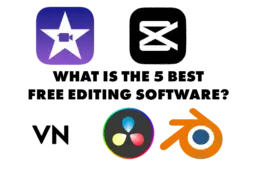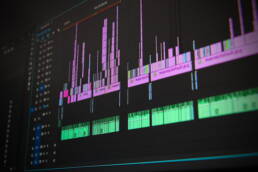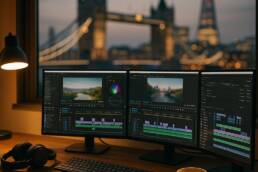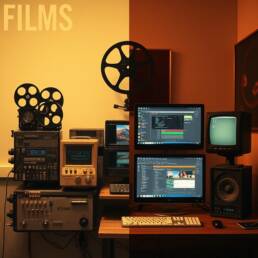
You’ve shot the footage, the hard drive’s groaning under the weight, and the client’s already asking:
“When can we see the first cut?”
But hold on — are you a film editor or a video editor?
Aren’t they the same thing?
Short answer: Not quite.
Long answer: Let’s unpack this, one frame at a time.
Table of Contents
Toggle
A Quick History: Film Editing vs Video Editing Origins
Table of Contents
ToggleBack before hard drives and cloud backups, editing was a hands-on craft.
-
Film editing meant slicing and taping strips of physical film with scissors, splicing tape, a lot of sore thumbs. Editors were part technicians, part artists.
-
Video editing emerged later, as magnetic tape and then digital files replaced celluloid. Computers took over the cutting table, and software replaced scissors.
For beginners, understanding this isn’t just trivia. It’s the root of how editing workflows, mindsets, and even job titles evolved.
Different Roles: What Film and Video Editors Actually Do
Let’s break down the key differences between a film editor and a video editor — especially if you’re just starting your creative journey.
| Film Editor | Video Editor | |
|---|---|---|
| Main Goal | Tell a long-form story (focus on emotion, pacing, character arc) | Deliver polished, clear content for platforms and clients. |
| Typical Projects | Feature films, TV shows, documentaries | YouTube, social media, branded content, weddings, corporate videos |
| Workflow | Structured process: assembly → rough → fine → final | Flexible process: fast drafts, client feedback, quick revisions |
| Clients | Directors, producers, creative studios | Businesses, marketing teams, influencers, private clients |
When it comes to video editing vs film editing careers, it’s about storytelling at different speeds.
Film editors work for months on a single story; video editors might finish three projects in a week.
Software: Same Tools, Different Mindsets
Whether you’re editing a YouTube vlog or a Netflix documentary, both types of editing now use digital software. So what’s the difference?
| Software | Film Editing Use | Video Editing Use |
|---|---|---|
| Avid Media Composer | Industry gold standard for feature films and TV | Rare outside of broadcast or studio work |
| Adobe Premiere Pro | Popular for indie films and web series | Very popular for social media and business videos |
| DaVinci Resolve | Often used for high-end grading in film | Increasingly common for YouTube, corporate and client videos |
There’s no hard rule here. The same program can be used for both, but the intent is different.
For easy video editing for beginners, tools like Movavi offer AI-assisted features that speed up things like background removal, clip selection, and even auto-cutting — perfect for content creators working on YouTube or TikTok.
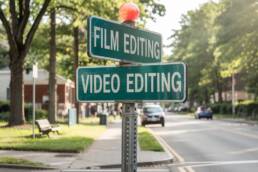
Career Paths: Oscars or Algorithms?
Let’s be honest here, most editors bounce between roles, especially when starting out or trrying to fill out a gap in the calander.
But if you’re choosing, here’s how to think about it.
Film Editing Career:
-
Focuses on long-form storytelling.
-
Involves working with directors, assistant editors, and post houses.
-
Often uses a structured timeline, formal review cycles, and a slow burn to final delivery.
-
More chance of awards, less chance of quick paydays.
Video Editing Career:
-
Highly adaptable: YouTube channels, weddings, social media, advertising.
-
Faster turnaround and more client feedback.
-
Great for freelancers, often remote-friendly.
-
Can be lucrative, especially with repeat clients or branded content.
So: which is better — film editing or video editing?
It depends on whether you prefer polishing one masterpiece over months or delivering multiple projects on a weekly basis.
Where the Line Blurs
Modern productions mix both worlds.
A Netflix show might be cut in Adobe Premiere. A corporate training video could be shot with a cinema camera. A TikTok influencer might spend more time editing than a documentary filmmaker on deadline.
Is video editing the same as film editing?
Not quite. Film editing is usually for long-form narrative, video editing often focuses on fast-turnaround content. But the craft of pacing, rhythm, storytelling is universal.
If you can:
-
Respect continuity,
-
Balance storytelling with audience expectations,
-
Fix bad audio and clumsy camera moves with creativity…
You’re halfway to mastering either path.
Final Thoughts: Choose Your Own Editing Adventure
Whether you’re trimming social media snippets or fine-cutting a feature film, the question isn’t film editing vs video editing — it’s what do you want to make?
Start small, use tools that fit your needs, and develop your style.
For beginners, platforms like Movavi or Capcut offer easy video editing for beginners with AI tools that handle technical headaches, freeing you to focus on the creative stuff.
Because let’s face it:
Being self-employed, we have to adapt or die.
Frequently Asked Questions:
Film editing focuses on long-form storytelling like movies and documentaries, while video editing is often for short-form projects like social media, marketing, or client content.
DaVinci Resolve, CapCut, and Premiere Rush are great starting points for beginners learning to cut YouTube videos.
Learn the basics of video editing for beginners, choose a platform (Adobe Premiere, Resolve, or Movavi for fast-start projects) and start building a portfolio. Whether you aim for film or video depends on your passion and pace.
Related Posts
101 Questions Every Video Editor Had to Ask
January 10, 2025
Can Video Editing Be Replaced by AI?
December 10, 2024
Joe Savitch-Lee
Over 20 years in media, having worked on four continents and on countless projects both on location and in a suite. He has excelled in both building/maintaining editing systems and editing them.





